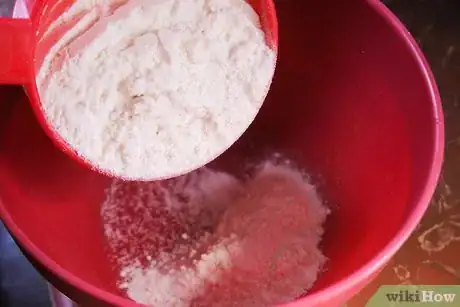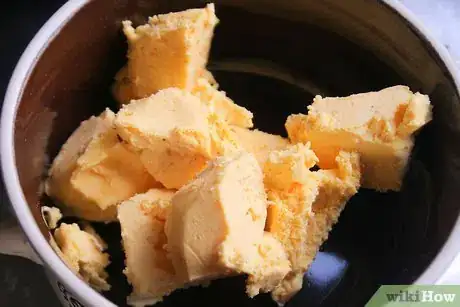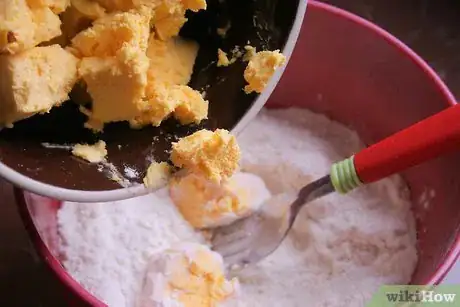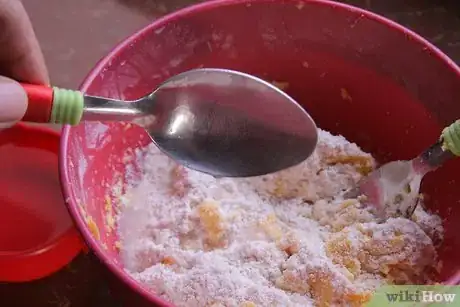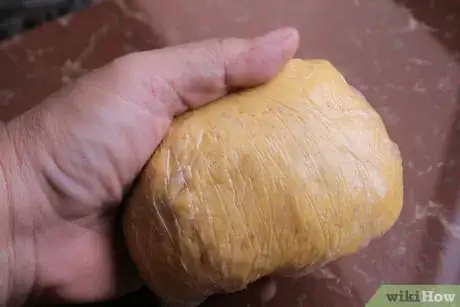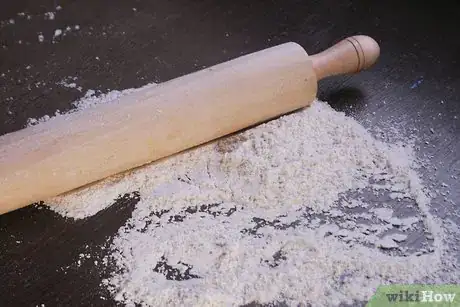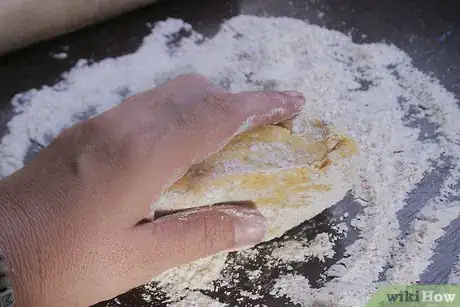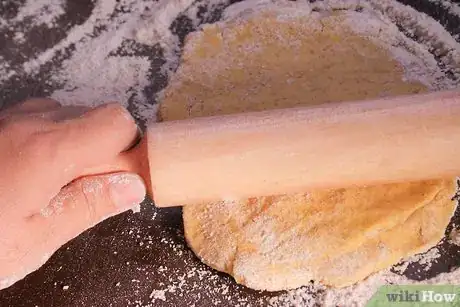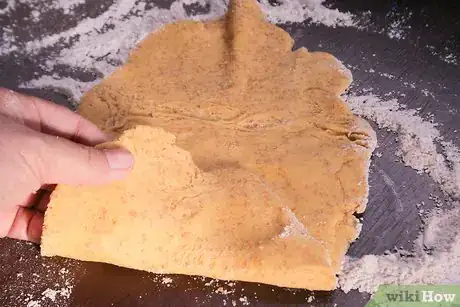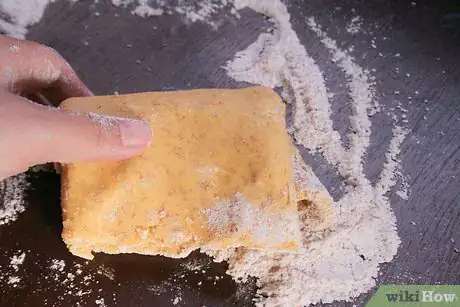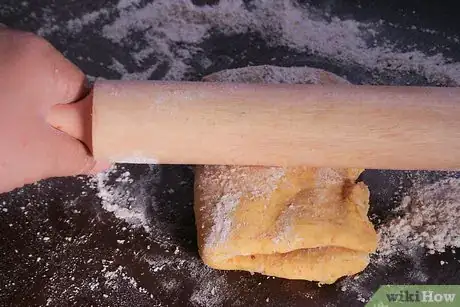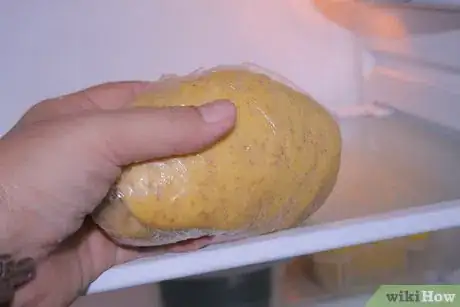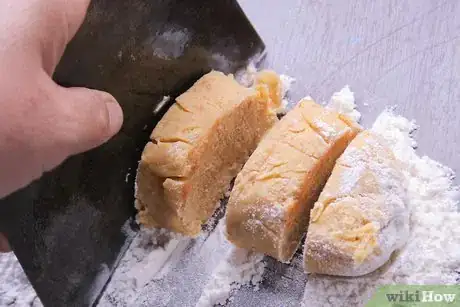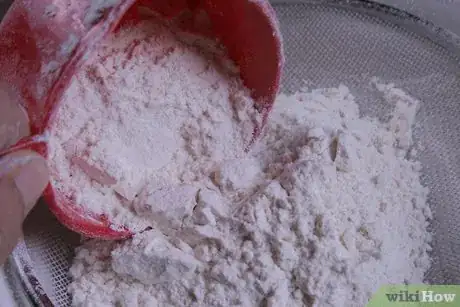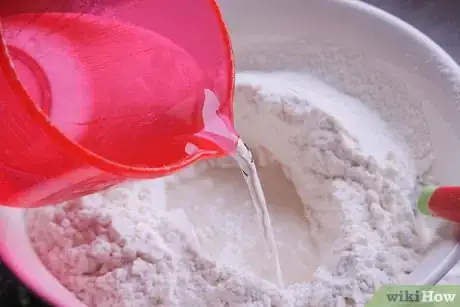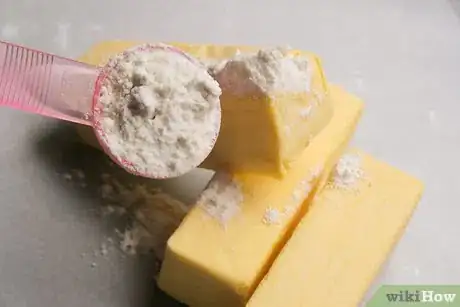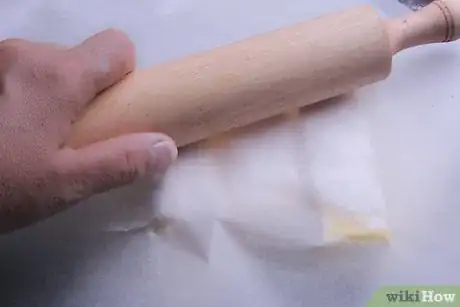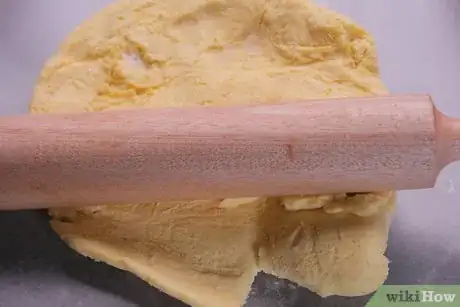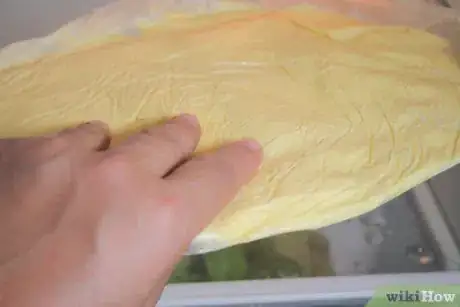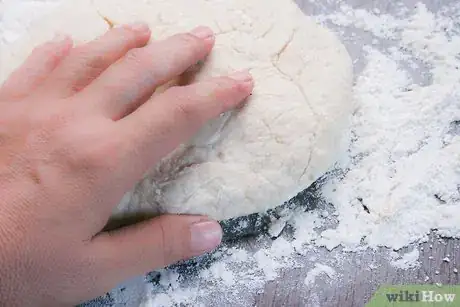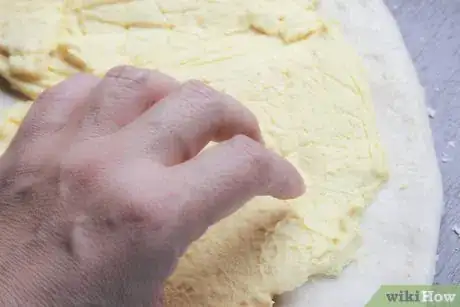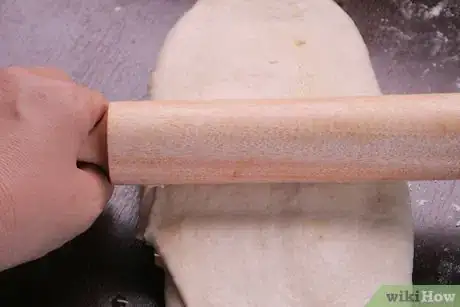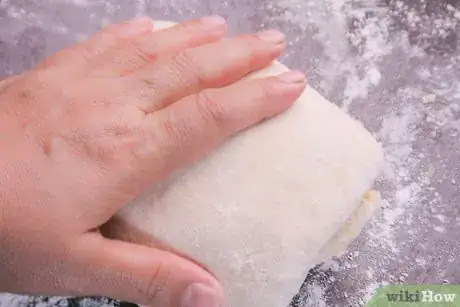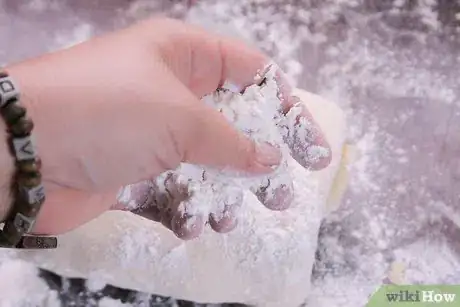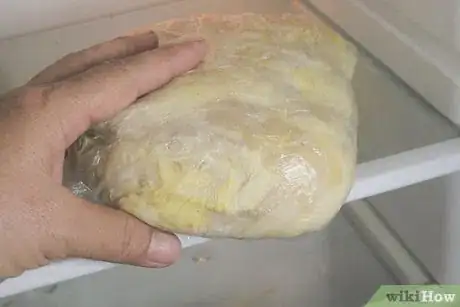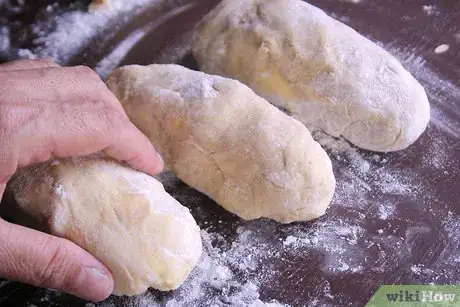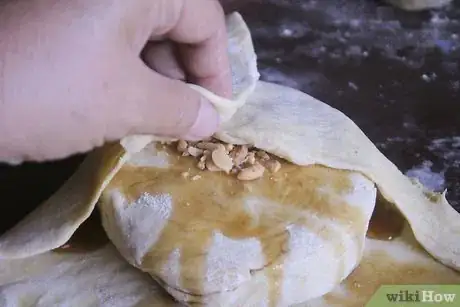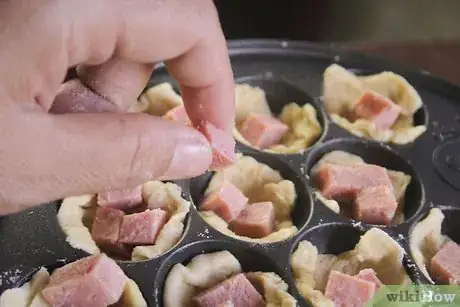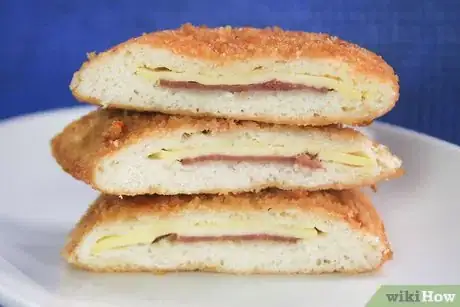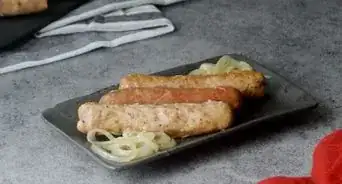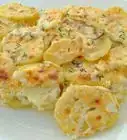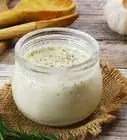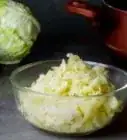This article was co-authored by wikiHow Staff. Our trained team of editors and researchers validate articles for accuracy and comprehensiveness. wikiHow's Content Management Team carefully monitors the work from our editorial staff to ensure that each article is backed by trusted research and meets our high quality standards.
There are 8 references cited in this article, which can be found at the bottom of the page.
This article has been viewed 703,636 times.
Learn more...
Puff pastry can be time consuming to make, but the results are worth it. If you have a recipe that requires puff pastry and you do not have access to the pre-made frozen kind, you can make your own. This recipe will show you two different ways to make puff pastry dough. It will also give you some recipe ideas as well.
Ingredients
- 1 cup (110 grams) all-purpose/plain flour
- ¼ teaspoon fine salt
-
10 tablespoons (5 ounces) butter, cold
- In the US, a stick of butter has 8 tablespoons.
- ⅓ cup (80 milliliters) ice cold water
Ingredients for the Dough:
- 3 cups (330 grams) all-purpose/plain flour
- 1½ tablespoon granulated sugar
- 1½ teaspoon salt
- 2 teaspoons lemon juice
- ¾ to 1 cup (180 to 240 milliliters) water, chilled
Ingredients for the Butter Square:
- 24 tablespoons (3 sticks) unsalted butter, chilled
- 2 tablespoons all-purpose/plain flour
Steps
Making Simple Puff Pastry
-
1Pour the flour and salt into a food processor and pulse for a few seconds. This combines the flour and salt evenly. If you do not have a food processor, then pour the flour and salt into a bowl and mix with a fork.
- If you are unable to purchase all-purpose flour, then use plain flour.
-
2Cut the butter into cubes. This will help the butter soften faster and make it easier to blend into the flour and salt.Advertisement
-
3Add the butter a little bit at a time to the food processor and mix. Pulse the food processor for a few seconds before you add more butter. This makes the butter more manageable and prevent the blades from getting stuck.[2]
- If you do not have a food processor, put the butter into the bowl and mix it lightly with the flour using a fork. Then, roll a pastry blade across the butter and flour using a back and forth motion. Keep lifting and rocking the pastry blade until you have a rough, crumbly texture. The butter chunks should be roughly the size of a pea.[3]
-
4Add the cold water and pulse for a few more seconds. The dough will start to come together and pull away from the sides of the bowl.
- If you are using a bowl, lightly pat the dough down with your hands, then make a small well in the center. Pour the water into the well and mix with a fork until the dough starts to come away from the sides of the bowl.
-
5Cover the dough with plastic wrap and put it into the refrigerator for 20 minutes.[4] This gives the butter time to cool back down, and prevents your dough from becoming too soft. After 20 minutes are up, take the dough out and unwrap it.
-
6Lightly flour your cutting board and rolling pin. This prevents the dough from sticking to everything. Be sure to keep a bag of flour on hand, in case you have to add more flour to your work surface; the dough will absorb the flour as you work with it, making the work surface sticky.
-
7Turn the dough onto the cutting board. The dough may feel dry, but this is normal. Do not add water to it; it will become softer the more you work with it.
-
8Form the dough into a flat square by kneading it gently. Do not make the dough too thin; you will be rolling it out some more later. You may see some streaks of butter in the dough, which is also normal. Do not attempt to mix the butter in.
-
9Use the rolling pin to roll the dough out into a rectangle. Roll in one direction only. The dough should be three times longer than it is wide.[5]
-
10Fold the dough into thirds. Take the bottom third of the rectangle, and fold it just past the middle. Take the upper third of the rectangle and fold it down on top of the rest of the dough, making a square.
-
11Rotate the dough 90 degrees to either side. It does not matter which side: left or right. If the dough does not turn easily, it means that it has begun to stick to the cutting board. Gently lift it up and spread some more flour down onto the board. Set the dough back down and try rotating it again.
-
12Repeat the rolling, folding, and turning process six to seven more times. In this way, you are creating thin layers in the dough.
-
13Wrap the dough in plastic wrap and put it in the refrigerator. Leave it in there for at least one hour, or overnight.
-
14Use the dough. Once the dough has thoroughly chilled, you can take it out of the refrigerator, roll it out, and use it to make croissants, filled pastry bites, or even baked brie cheese.
Making Traditional Puff Pastry
-
1Mix the flour, sugar, and salt in a food processor for a few seconds. This will allow at the salt and sugar to become evenly distributed throughout the flour. If you do not have a food processor, then put everything into a bowl and stir it briskly with a fork. You can also use plain flour instead of all-purpose flour.
-
2Add the lemon juice and part of the water into the food processor while it is still running. Start with ¾ cup (180 milliliters) of water; you will be adding the rest later, depending on how dry the dough is. Most food processors should have a spout at the top where you can pour ingredients through without taking the lid off. After a while, the dough should start to come away from the sides of the food processor. If the dough is still too dry and has floury clumps in it, add the rest of the water, one tablespoon at a time. Do this until the dough clumps together and comes away from the walls of the food processor.
- If you do not have a food processor, make a hole in the middle of your flour mixture, and pour the lemon juice and water in. Stir it with a fork until the dough clumps together.
- The lemon juice will help make the dough more elastic and easier to roll out.[6] You won't taste it once you bake the pastry.[7]
-
3Transfer the dough onto a sheet of plastic wrap and pat it into a square. The square should measure 6 inches (15.24 centimeters) on each side. Do not make the square too thin.
-
4Wrap the dough up and put it in the refrigerator for one hour. This will make the dough easier to work with later. During this time, you can start preparing the butter.
-
5Put unwrapped butter sticks on a sheet of parchment paper and cover them with 2 tablespoons of flour. Make sure that the butter sticks are touching each other and that the flour is spread evenly across them.
-
6Cover the flour and butter with another sheet of parchment paper and mash it with a rolling pin. Keep doing this until the flour becomes ingrained in the butter. Once you are done mashing, remove the top parchment sheet.
-
7Roll the butter out into a square. The square should measure 8 inches (20.30 centimeters) on each side.
-
8Wrap the butter with plastic wrap and put it into the refrigerator. Leave it there for one hour. This will allow the butter to cool back down and become more manageable later.
-
9Unwrap the dough and roll it out on a lightly-floured surface. You want to end up with a square that it is about 11 inches (27.94 centimeters) on each side.
-
10Set the butter in the middle of the and wrap the dough around it. Unwrap the butter and position it so that the corners are touching the flat sides of the dough square. Then, lift the corners of the dough and fold them towards the middle of the butter, creating a square-shaped packet.
-
11Roll the packet out into a rectangle. Do not make it too thin, and make sure that the rectangle is three times longer than it is wide.
-
12Fold the dough into thirds. Life the bottom third up and bring it just past the middle of the rectangle. Press it down. Next, lift the top third and bring it down onto the rest of the dough, creating a square.
-
13Turn the dough packet to one side by 90 degrees. You can turn it to the left or right. If the packet does not turn easily, the dough likely soaked up the flour. Gently lift the packet up and spread a thin layer of flour onto your work surface. Set the packet back down and try turning it again.
-
14Repeat the rolling and folding one more time. Roll the dough out into a rectangle and fold it into thirds again. You are doing this to create thin layers of dough and butter.
-
15Wrap the packet with plastic wrap and put it in the refrigerator. Let it there until it becomes firm; it should take about 20 minutes depending on how cold your fridge is.
-
16Roll and fold the dough into thirds four more times, chilling it in between. After you roll, fold, and rotate the dough two times, put it into the fridge for 20 minutes, then roll, fold, and turn it two more times.
-
17Put the dough into the refrigerator for one hour before baking with it. At this point, you can start using your dough in your recipe.
Baking with Puff Pastry
-
1Make puff pastry shells. Roll out your puff pastry into a thin sheet, then cut it into circles using a circle-shaped cookie cutter or drinking glass. Lightly indent the center of each circle with a smaller cookie cutter or a cap (such as from a spice jar). Lightly poke the inner circle a few times with a fork. Transfer the circles to a baking sheet and bake at 400°F (205°C) for 15 to 20 minutes. Take the pastry out of the oven and either pat the inner circle down with the bottom of a spice jar or wooden spoon, or lift the inner circle out completely. You can now fill the cups with cream, fruit, or any cooked filling.[8]
-
2Use puff pastry to make baked brie. Roll out your puff pastry until it is slightly bigger than your wheel of brie cheese. Set the cheese in the middle of dough and pour some honey over it. You can also add nuts and dried fruit. Bring the corners of the dough towards the middle of the cheese, creating a packet. Bake the brie on a baking sheet at 350°F (175°C) for 25 to 30 minutes. You can serve the baked brie with apple slices and crackers.[9]
-
3Make some filled pastry puffs. Roll out the puff pastry dough into two thin 10 by 14 inch (25.4 by 35.65 centimeter) rectangles. Cut each sheet into 24 smaller rectangles. Press the rectangles into the wells of a mini muffin tin. Bake at 375°F (190°C) for 10 minutes. Take the pastries out of the oven and pat the center of each with the end of a wooden spoon or spice bottle. Fill the pastries with whatever you want, then put them back into the oven for 3 to 5 minutes. Here are some ideas for what you can fill the pastries with:
- Ham and cheese
- Sautéed mushrooms and onion
- Brie, pistachios, and peach preserves
-
4Make a ham and cheese pastry. Roll the pastry into two 10 inch by 12 inch (25.40 by 30.48 centimeters) squares. Place one of the squares on a baking sheet and brush it with mustard; leave a 1" boarding. Cover the sheet with a layer of ham slices, then cover the ham with Swiss cheese slices. Spread egg wash around the border and cover it with the second pastry sheet. Press the edges together, then brush the top pastry with egg wash. Bake at 450°F (233°C) for 20 to 25 minutes. Allow the puff pastry to cool, then cut it into squares and serve.[10]
- To make the egg wash, whisk together 1 egg and 1 tablespoon of water in a bowl.
-
5Make some herb and cheese twists. Roll some puff pastry dough into a 10 by 14 inch (25.4 by 35.65 centimeter) rectangle. Brush one half of the pastry with egg wash. Mix 1/3 cup (35 grams) grated Parmesan cheese and 1 teaspoon dried Italian seasoning in a bowl, then spread over the other half of the puff pastry. Fold the pastry in half, so that the egg side touches the cheesy side. Cut the pastry into 24 strips. Twist each strip into a spiral, then brush each strip with some egg wash. Bake at 400°F (205°C) for 10 minutes. Let cool before serving.
- To make the egg wash, beat an egg and a tablespoon of water together in a small bowl.
Community Q&A
-
QuestionCan I find pastry squares at the local market?
 Community AnswerYes, most stores will carry either squares or something similar. Some small stores may not care them.
Community AnswerYes, most stores will carry either squares or something similar. Some small stores may not care them.
Warnings
- Try not to over-handle the dough. Work as quickly as you reasonably can.⧼thumbs_response⧽
- This is the kind of crust you'd use to top a savory pie, like a potpie, to wrap a beef wellington or sautéed mushrooms, or over a tarte tatin. Don't use this kind of pastry under a heap of cinnamon apples or pumpkin puree.⧼thumbs_response⧽
Things You'll Need
- Food processor
- Refrigerator
- Rolling pin
References
- ↑ Dessert for Two, 15-Minute Puff Pastry
- ↑ Food Network, Quickest Puff Pastry Recipe
- ↑ Dessert for Two, 15-Minute Puff Pastry
- ↑ BBC Good Food, Rough-Puff Pastry
- ↑ BBC Good Food, Rough-Puff Pastry
- ↑ Baking Matters, Puff Pastry
- ↑ Diana's Desserts, Tips for Pastries
- ↑ Always Order Dessert, Inspired Entertaining: DIY Puff Pastry Shells
- ↑ Simply Recipes, Baked Brie
- ↑ Food Network, Ham and Cheese in Puff Pastry
About This Article
To make puff pastry, you’ll need 1 cup of all-purpose flour, a ¼ teaspoon of fine salt, 10 tablespoons of cold butter, and 1/3 of a cup of ice cold water. Combine flour and salt in a food processor and pulse. Next add the cubed butter and water to the mix. Pulse a few more times, remove the dough, cover in plastic wrap, and refrigerate for 20 minutes. Gently knead the dough, fold it in thirds, roll it, turn it, and repeat to create thin layers. Rewrap the dough and refrigerate for an hour. Once the dough is chilled, use it for croissants or filled pastries! For tips on how to make a traditional puff pastry, read on!
